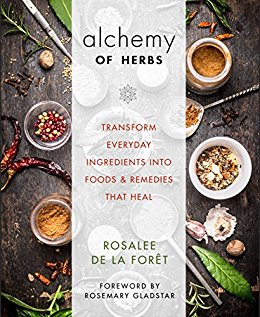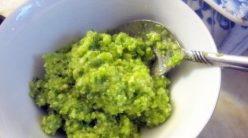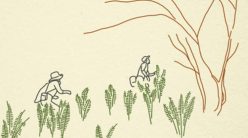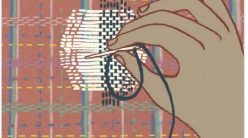I was excited to hear about Rosalee De La Foret’s new book, Alchemy of Herbs*, as the author is part of the Learning Herbs site that I have followed for years. I highly enjoy their blog posts and newsletter for kids about the benefits of plants that you can find in the wild. Our family makes heavy use of healing plants (especially wild ones), and I was eager to learn more.
The book includes information and recipes for 29 recommended herbs. These are: black pepper, cayenne, cinnamon, fennel, garlic, ginger, holy basil, lavender, mustard, nutmeg, parsley, peppermint, rosemary, sage, thyme, turmeric, nettle, elder, hawthorn, lemon balm, rose, tea, artichoke, cacao, chamomile, coffee, dandelion, ashwagandha and astragalus.
There are things I loved about the book but there were also things that annoyed me again and again. None of these things might bother you at all, but I’ll list them in case it’s helpful.
Pros:
- This is a nicely sized, thorough book for the low price (currently low anyway, the suggested retail price is higher), especially since it has color photos.
- The author gives a ton of medical information about herbs in general and each specific herb she profiles, including citing references to a vast number of scientific studies.
- I enjoyed reading about the hot/cold, dry/moist aspect of herbal healing in the Western tradition and how the plants corresponded, especially since I recently attended a workshop about the similar teachings in Chinese medicine with Yin/Yang.
- I like the idea of using these plants as foods and beverages, not in pill form.
Cons:
- I was frequently frustrated by the measurements. The author explained that she gives dosage information in grams because it’s easier to weigh but I would have so appreciated a general estimation of how much that is. For instance, she says about cinnamon: “The therapeutic amount for cinnamon is 1 to 6 grams per day.” How much is that? Could she just give me a rough idea of whether that’s a teaspoon or a quarter cup? Anything???? Every single plant is that way, and while I understand that you want to weigh for precision, if I am planning whether to buy a bunch of something I need some sort of clue about the quantities and what sort of amount I’m going to need to work into our family’s diet.
- I was expecting the herbs to be ones that I could forage (gather wild) or purchase inexpensively in a grocery store. This is not generally the case. For instance, artichokes are listed as one of the 29 recommended herbs — but not the flower part that we eat, which is sold in stores. She recommends consuming 2 to 6 grams of artichoke leaves (found lower on the plant, she says) or a tincture 3 times a day. I live in Minnesota and am trying to grow artichokes in my garden this year (which requires an insanely long starter period inside first) but artichoke leaves are not something most of us have access to. The only recipes she offers for artichoke leaves are for a tea and for bitters. Otherwise, this seems like one of those “take 3 capsules” kinds of things. Not many of us are able to find artichoke leaves and there are no cooking recipes in the book to use them even if we could.
- I would have loved more suggestions for how to use the herbs. Each section goes into some rather thorough information about how the herb can be helpful for various ailments, and then there is the recommended therapeutic dose in grams and generally about two recipes. Some of the recipes seem interesting but what I would really appreciate is a LIST of good ways to use that much of each herb REGULARLY in cooking. After all, the author points out that we should consume most of them often and in large amounts. It would have been simple and so helpful for each herb to have a list at the end of its section for other ways to incorporate it into regular meals such as “Other ways to incorporate X into meals include: stir a teaspoon into oatmeal, add to smoothies, stir into yogurt, add one teaspoon to chili…”. After she convinced me of the benefits for some of the plants listed, I really wanted to use them but had no clue what else to do with them besides the couple of recipes she gave.
- This is also not a book for foragers, which surprises me since she’s affiliated with one of my favorite foraging websites. There is no ID information given on the plants that you can gather in the wild. There’s not even information on how to grow them in your garden.
- Finally, vegans and vegetarians take note: While the author says repeatedly that people who follow any diet can use the book, she includes quite a lot of meat, honey and other animal products in the recipes. This is probably not a drawback for most, but I’m mentioning it for those who care. For instance, the only recipes for lemon balm are for an infusion, for flavored water, and for lemon balm chicken. If you do not consume animal products, then the few recipes included may be of even less use.
In all, I do consider this a helpful book, but it was not as good as I felt it could be. At the current price, it’s probably an excellent addition to your bookshelf (or a worthy book to put on hold at the library). I will keep looking for that perfect herbal book for my family, though.
(*affiliate link.)







